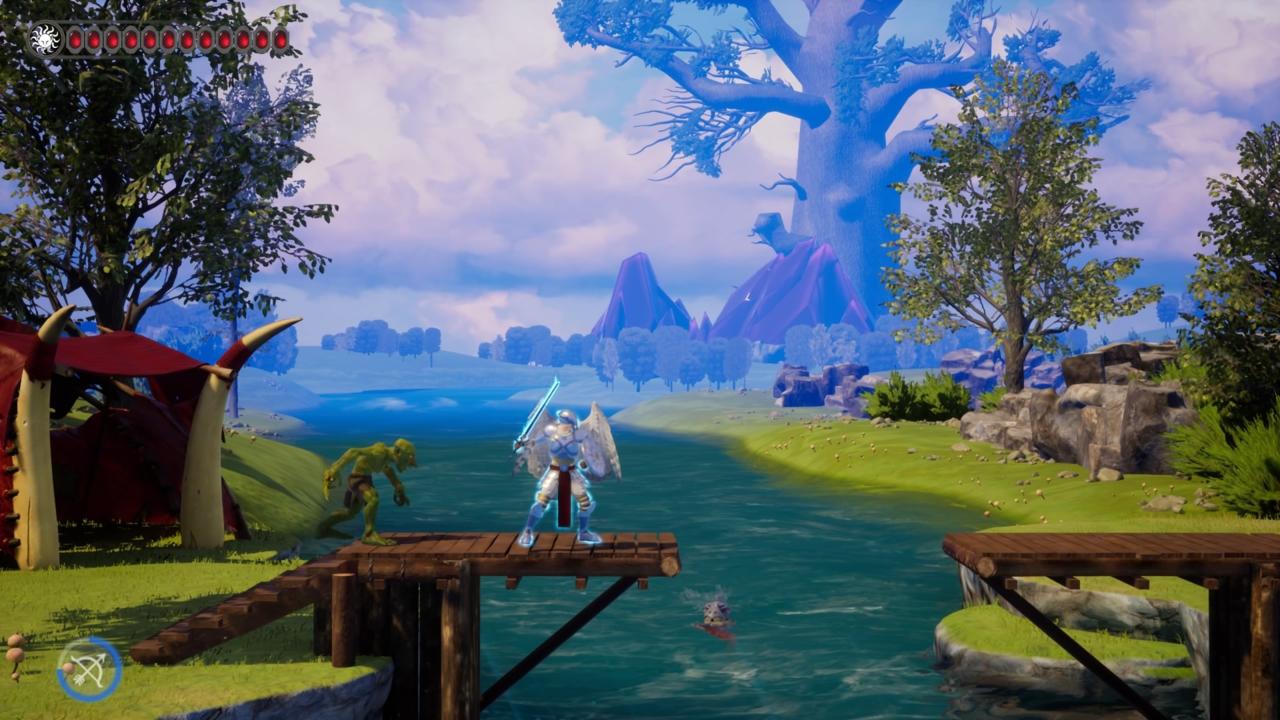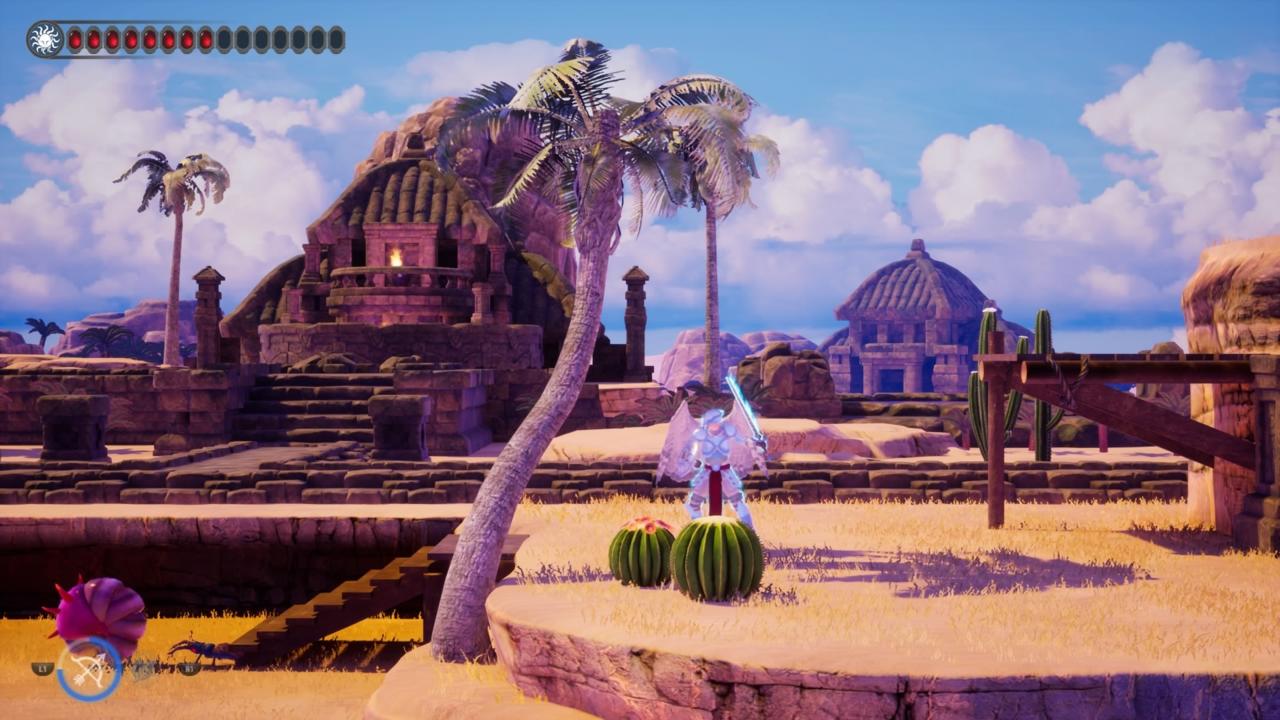SolSeraph is overtly inspired by the Super NES cult classic ActRaiser. If there was any shred of doubt of its roots given its mixture of action-platforming and sim-style management, that was removed when it opened with a slow spinning first-person view barrelling towards the earth--an homage to ActRaiser's Mode-7 showpiece so specific that it virtually winks at the audience. Curiously, though, it's some of SolSeraph's departures from ActRaiser that let it stand on its own, for better and for worse.
SolSeraph puts you in the divine boots of Helios, the Knight of Dawn, as he helps build civilization and fight against a set of Younger Gods who each manifest as the embodiment of a natural disaster. There is a hodge-podge of religious iconography at play, and Helios looks especially angelic, but this isn't tied to any specific faith. Instead, SolSeraph invents its own mythology, borrowing bits and pieces from world religions.

Each of the five territories consists of two distinct game types. To begin, you fight through monsters to unlock a new civilization. Each one is housed on its own environment type which presents its own set of hazards. An island nation is prone to constant flooding, for example, while the snowy northern tribe has trouble tending farms and needs to rely on livestock instead. You guide the people to manage their population and resources, like food and lumber, while also building defensive structures to fend off attacks from monsters. Then you can build a temple near one of the monster lairs, take part in another action-platforming or arena battle to clear it, and continue until you unlock the final portion that houses the Younger God boss.
This all may sound very familiar to ActRaiser fans, but the focus on defending against waves of monster attacks is actually a wild departure. SolSeraph's approach is more akin to a tower defense game, as the waves of monsters all march on a set path toward a centralized base marked by a campfire. Defeating waves of monsters takes a variety of defensive structures, even earning its own part in the radial menu, along with the godly powers to summon lightning or dispatch a guardian. In short, it takes the formerly minor threat of monster attacks and makes it much more active and central to the experience.
On one hand, this change makes the sim portions feel that much more dynamic. Protecting your people from brutal waves of monster attacks can be much more frenetic than the relaxed, casual sensation of watching your society grow and occasionally guiding your people in the right direction. On the other hand, this approach comes at the expense of what made ActRaiser such an interesting examination of faith.
In ActRaiser, society grew on its own as you mildly steered them, and your tools were limited. You could summon an earthquake to destroy houses and encourage stronger building, but you couldn't meticulously place each individual building on a grid. In some ways, ActRaiser functioned as a reflection on the limitations of divinity. Interactions were indirect, and the stories that played out were sometimes tragic. The people assumed it must be the will of a higher power, but in reality, you were powerless to stop some events that they had set in motion by their own free will. It's a powerful idea that, in SolSeraph, is undermined by having such direct control over everything your civilization does.

The spirit is still there, to a point. The people pray to Helios without ever hearing an answer, so the idea is still present that they're operating on faith and hoping some dispassionate deity will end their struggles. But this is present only in short story sequences, and it's discordant with the mechanics of the game itself. There is no sensation that the culture is flourishing on its own. You aren’t gently guiding as much as dictating, which feels oddly out-of-step with the idea that the people have unproven faith in a higher power.
Functionally, the sim segments are relatively simplistic but often unintuitive. Monster waves come infrequently enough that it's often easy to build up a massive arsenal of defenses before the first attack ever comes. There's no real penalty for failure, and in fact getting a game over screen just starts the monster clock over again from zero while keeping all of your recent building changes. At the same time, it isn't always clear where the monsters will be coming from or in what numbers. Building temples to clear monster lairs relies on meeting a threshold of "Souls," which are gathered from defeated monsters. This can be counterintuitive in a game about a god gathering worshippers, who could also logically be counted as souls and more sensibly connect to building a worship temple. Instead, the population only matters inasmuch as it gives you bodies to assign to defensive structures and farms. There is no counter for your total number of assigned versus idle villagers, which means you may reassign them at a critical moment by accident.
The game’s other half, the action-platforming segments, can be unforgiving. The controls are rigid and monsters come from all sides, which often makes it difficult to turn quickly to take on different threats. Life comes at a premium, with very sparse health regen and a magic spell that only recharges one measly health point at a time. Checkpoints are often nowhere to be found, which is especially frustrating when you accidentally wander into an optional area with a tougher battle that grants some small permanent reward like extra Weather Magic for the sim portion.

Much more problematic in the action sequences is the interplay between the foreground and background. Helios does his battle strictly on one plane, but enemies often approach from the foreground or background. You can see them approaching, but until they reach your plane, slashing with your sword won't touch them. The transition between untouchable and vulnerable isn't clearly signaled, so oftentimes your best bet is to slash wildly at an approaching enemy until it takes damage--but since some of them fly diagonally towards you, this isn't foolproof. The interplay between these areas can present a good challenge when it's just background characters firing projectiles that you'll need to dodge, but the tendency for enemies to cross from one plane to another just creates more frustration than it's worth.
The Younger Gods boss characters are the exception to this rule and where the combat shines. The old-school challenge isn’t hampered by the gimmick present in normal enemy encounters. Better yet, the collection of boss designs are largely a creative mixture of different cultural traditions from around the world, and each one’s power set and attack patterns connect with the natural disasters they have represented for your people. Defeating them grants you a new power, but it’s nearly as satisfying to have defeated the personification of floods, drought, or wildfires, after watching your culture struggle with them.
SolSeraph could have hemmed slightly closer to the conventions of its clear inspiration, and it may have been better for it. The changes to the sim aspect create gameplay depth at the expense of tonal depth, and the action segments can be annoyingly clunky, especially with the unnecessary addition of enemies that are untouchable until an unclear point in time. The willingness to riff on one of the most beloved classics of an entire console era shows a remarkable amount of audacity, and it actually halfway works. It's the half that doesn't that makes SolSeraph such a qualified recommendation.











